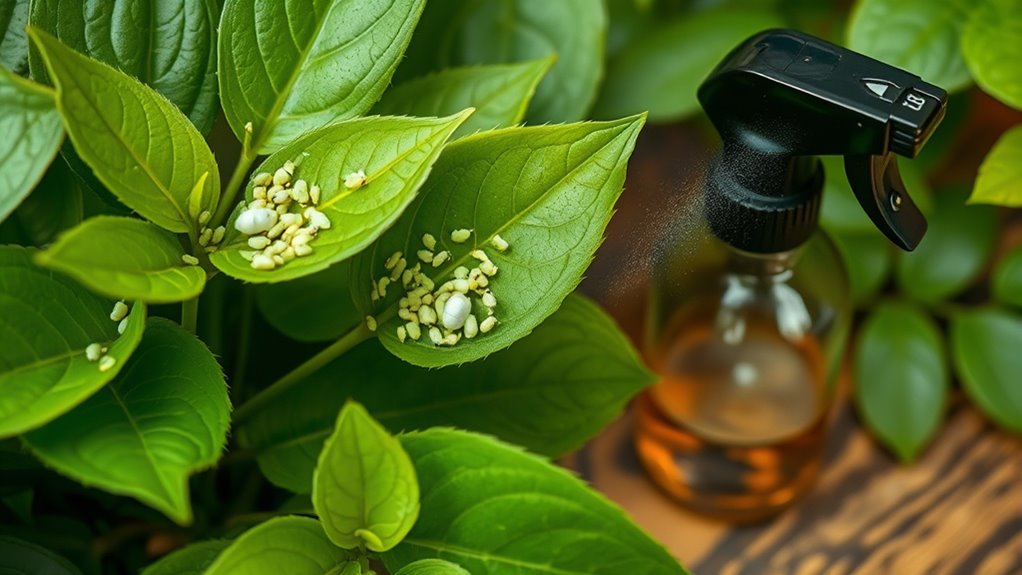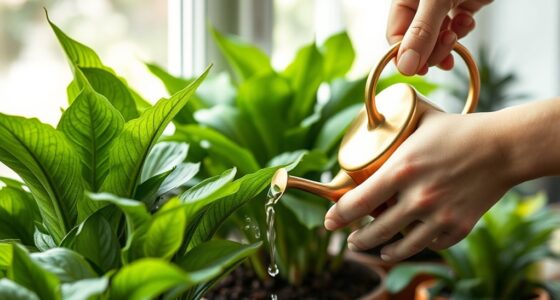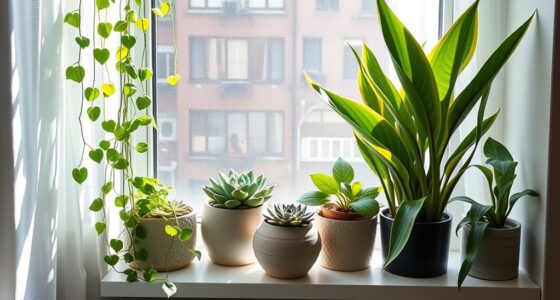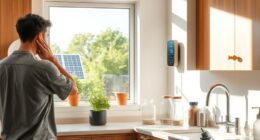To tackle common indoor plant pests like spider mites, aphids, and mealybugs, first identify the signs and pests on your plants. Use natural remedies such as neem oil, soapy water, or a water blast to control them effectively. Maintaining healthy plants through proper watering, good airflow, and cleanliness helps prevent infestations. For more tips on natural solutions and pest prevention, stay with us to protect your indoor garden thriving.
Key Takeaways
- Identify pests like spider mites, aphids, mealybugs, and scale insects by their distinctive signs and webbing.
- Use natural remedies such as neem oil, soapy water, or water blasts to effectively control common pests.
- Maintain plant health through proper watering, cleaning leaves, and ensuring good airflow to prevent pest infestations.
- Introduce natural predators like ladybugs or predatory nematodes to sustainably manage pest populations.
- Regularly inspect indoor plants to detect early signs of pests and respond promptly with eco-friendly treatments.
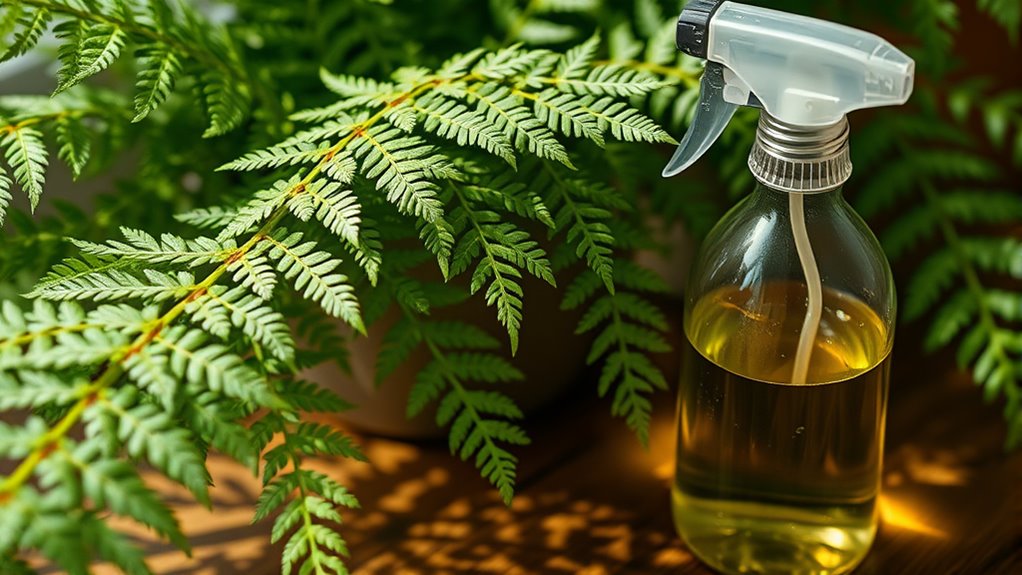
Indoor plants can brighten up any space, but they’re also vulnerable to pests that can quickly cause damage. When pests invade, your first priority should be pest identification. Recognizing common pests like spider mites, aphids, mealybugs, and scale insects helps you respond swiftly and effectively. Each pest has distinctive signs: spider mites leave fine webbing, aphids cluster on new growth, mealybugs look like cottony masses, and scale insects appear as small, hard shells. Accurate pest identification allows you to choose the most appropriate natural remedies and implement targeted treatment strategies, reducing the risk of widespread infestation.
Identify common indoor plant pests early to respond effectively and protect your greenery from damage.
Proper pest identification is a valuable skill that enhances your overall plant care routine. Once you’ve identified the pest, focus on disease prevention as part of your overall plant care routine. Healthy plants are naturally more resistant to pests and diseases. Keep leaves clean by gently wiping them with a damp cloth, which removes dust and potential pests. Avoid overwatering, as excess moisture can promote fungal growth and attract pests like fungus gnats. Proper airflow around your plants also helps prevent mold and rot, creating a less inviting environment for pests and disease. Regularly inspecting your plants allows you to catch problems early before they escalate. If you notice any signs of pest activity or disease, act promptly to prevent it from spreading.
Natural remedies are often effective and safer alternatives to chemical pesticides. For instance, a mixture of neem oil acts as a broad-spectrum pest deterrent, disrupting the feeding and reproduction of many common pests. You can prepare a neem oil spray by diluting it according to the instructions on the label and applying it directly to affected areas. Soapy water is another simple remedy—mix a few drops of mild liquid soap with water and spray it on pests like aphids and mealybugs. The soap suffocates these insects and makes it easier to remove them physically. For spider mites, a strong blast of water can dislodge them from the undersides of leaves, interrupting their lifecycle. Introducing natural predators, such as ladybugs or predatory nematodes, can also help keep pest populations in check without harming your plants or the environment.
Preventative care combined with timely pest identification and natural remedies creates a resilient approach to maintaining healthy indoor plants. Keep a close eye on your greenery, act quickly when pests appear, and use eco-friendly solutions to protect your investment. With consistent attention and care, you can keep your indoor garden vibrant, pest-free, and thriving for years to come.
Frequently Asked Questions
How Can I Prevent Pests From Entering My Home?
To prevent pests from entering your home, start with plant quarantine—inspect new plants thoroughly before bringing them inside. Choose pest-resistant plant varieties whenever possible, as they’re less prone to infestations. Keep your home clean and free of fallen leaves or debris, and regularly check your plants for early signs of pests. Proper watering and humidity control also help strengthen your plants’ defenses, making them less attractive to pests.
Are There Organic Pesticides Safe for All Indoor Plants?
Yes, there are organic pesticides safe for all indoor plants. Botanical insecticides, such as neem oil or insecticidal soap, are effective and gentle options. You can apply these organic pesticides directly to your plants, ensuring you cover both tops and undersides of leaves. Always follow the instructions on the label, and test a small area first to prevent any adverse reactions. This way, you protect your plants without risking their health.
How Often Should I Inspect My Plants for Pests?
Think of yourself as a vigilant plant scout, patrolling your greenery like a guardian. You should inspect your plants at least once a week, keeping a keen eye out for pests. Establish a regular pest schedule to catch trouble early, just like a watchtower scanning the horizon. This routine helps you catch signs of pests before they spread, ensuring your indoor oasis stays lush and healthy.
Can Natural Remedies Harm Beneficial Insects?
Natural remedies can pose risks to beneficial insects if used excessively or improperly. When you apply treatments like neem oil or insecticidal soap, you should consider beneficial insect safety by avoiding broad-spectrum options. To minimize natural remedy risks, target pests carefully and apply treatments during times when beneficial insects are less active, such as early morning or late evening. This way, you protect helpful insects while managing plant pests effectively.
What Are Signs of Pest Infestation Early On?
You might notice tiny specks or fuzzy patches on your plant’s leaves, which can look like a dust storm or cotton candy. Yellowing or browning leaves, distorted growth, or sticky residue are clear signs of pest infestation. Early pest identification saves your plant’s health, so keep an eye out for unusual spots, webbing, or tiny insects crawling—these are your plant’s warning signals to act quickly and prevent disaster.
Conclusion
By spotting pests early and using natural remedies, you can keep your indoor plants healthy and thriving. Did you know that over 70% of indoor gardeners have successfully managed pests without chemicals? Staying vigilant and choosing eco-friendly solutions not only protects your plants but also creates a safer home environment. With a little knowledge and effort, you can enjoy lush, pest-free greenery all year round. Keep learning and nurturing your indoor jungle!
